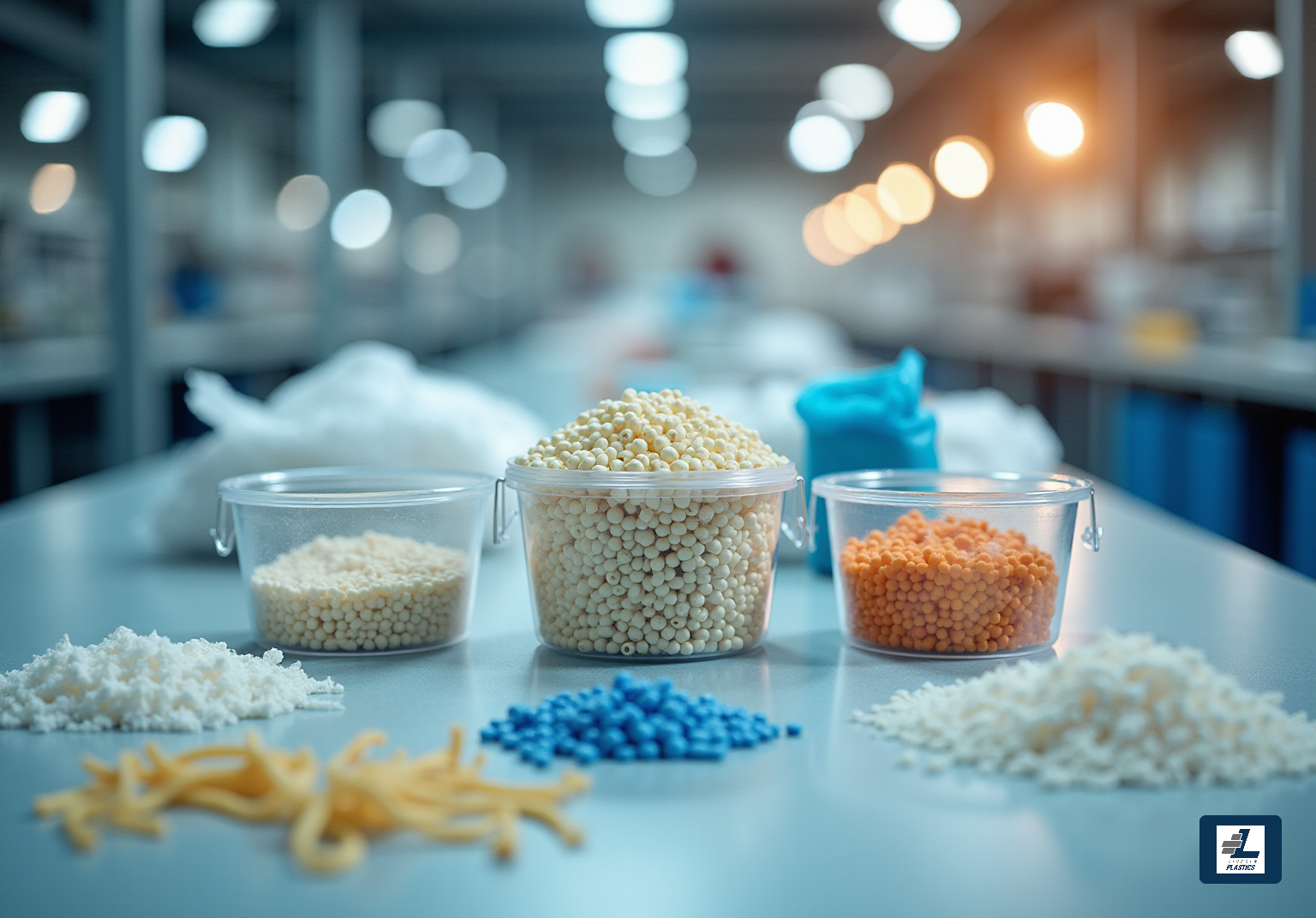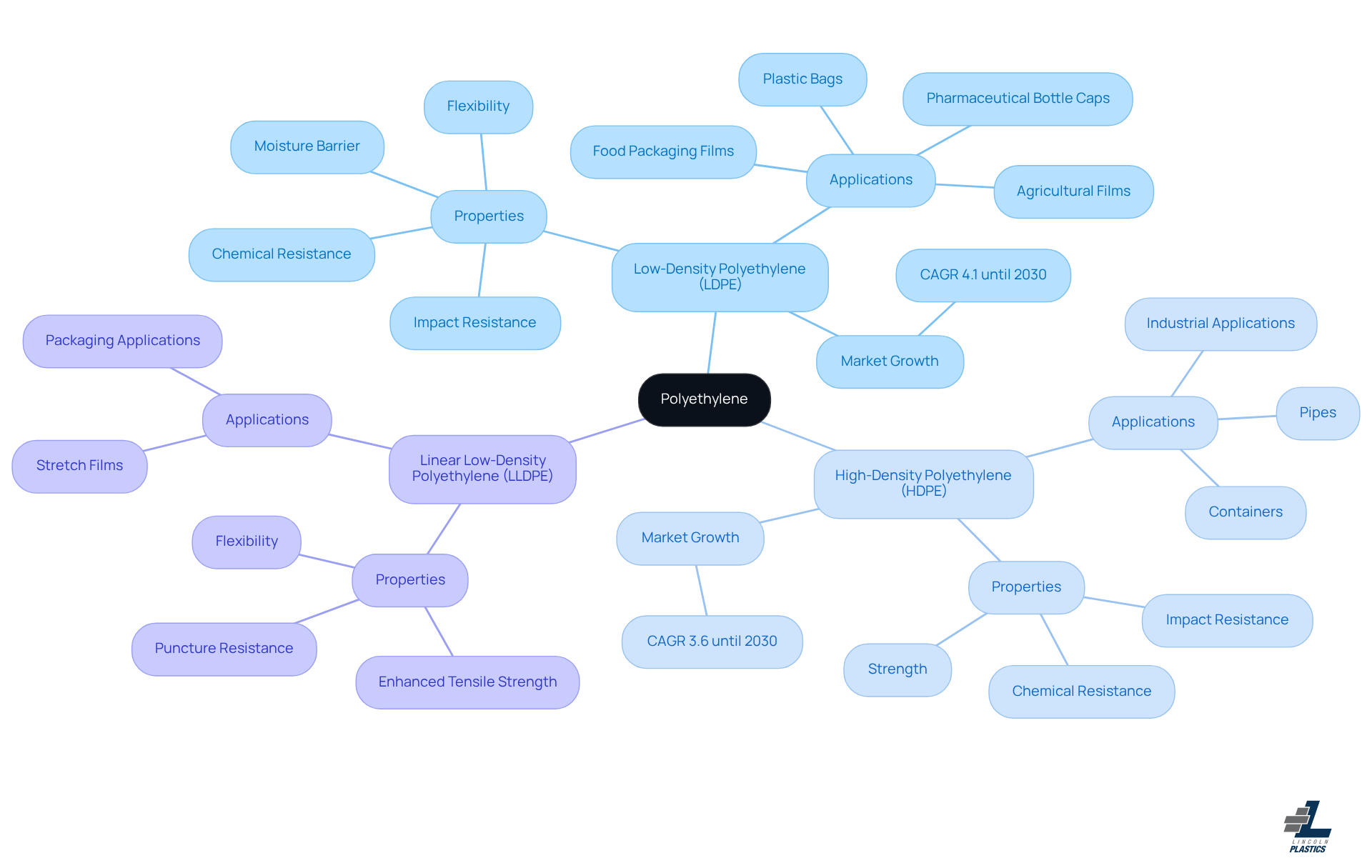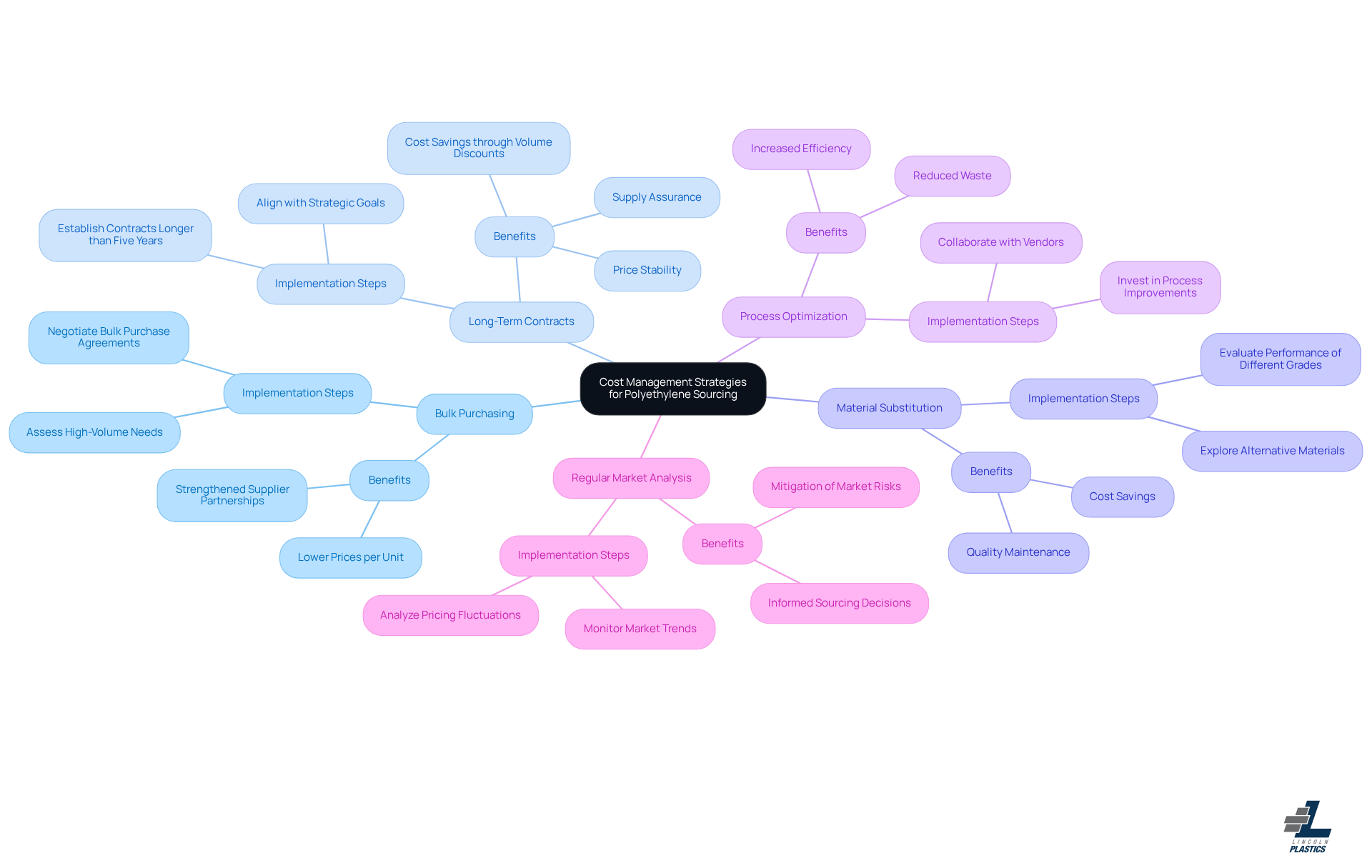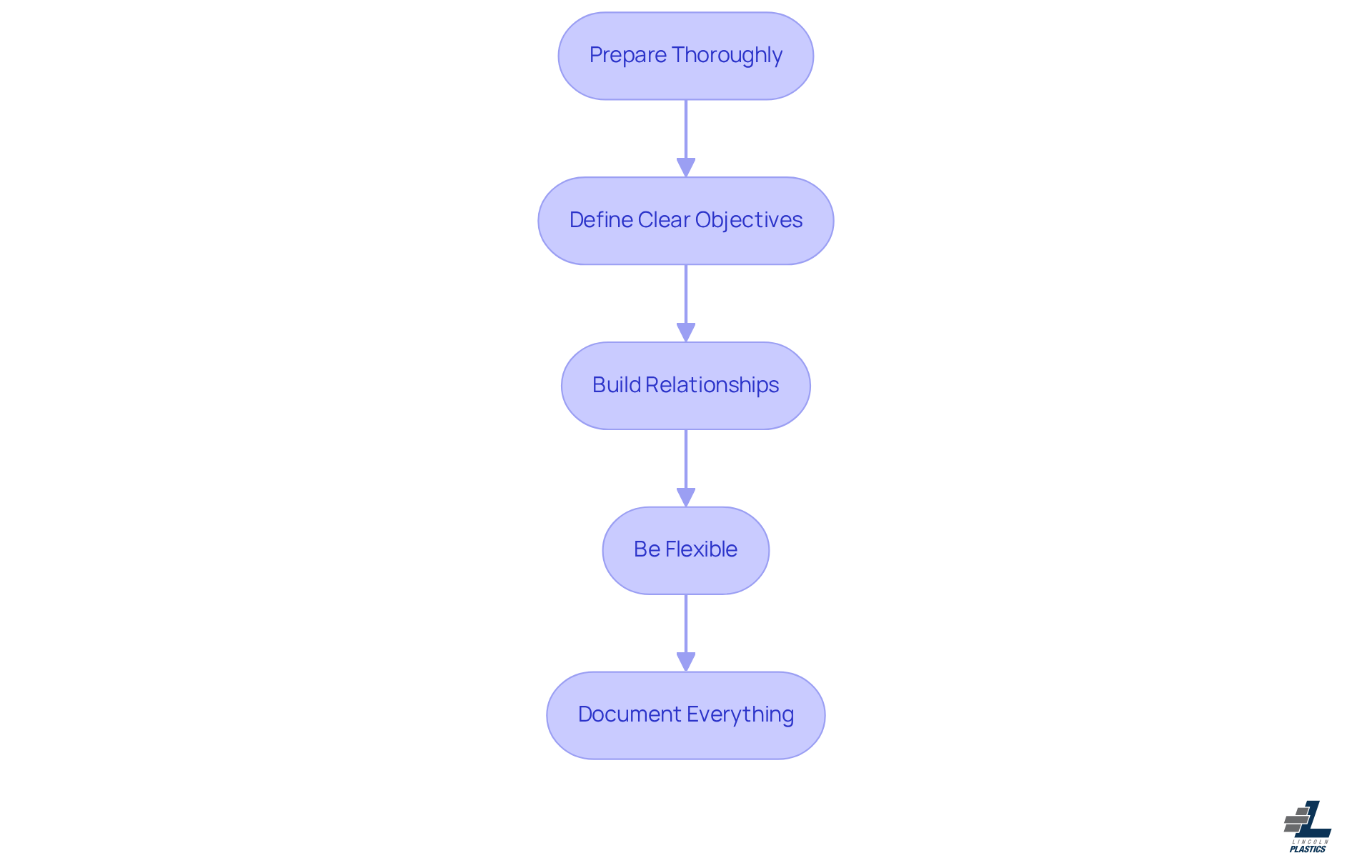
Master Plastic Polyethylene Sourcing: Key Strategies for OEM Managers
Overview
This article dives into some key strategies for OEM managers looking to source plastic polyethylene effectively.
Have you ever felt overwhelmed by the different types of polyethylene out there? It’s crucial to understand these variations. Plus, evaluating suppliers based on their quality and reliability is a must.
Now, let’s talk about cost management techniques. Implementing these can really make a difference in your sourcing decisions. And don’t forget about negotiating contracts! This step ensures that your choices align with industry demands and boost your operational efficiency.
So, are you ready to enhance your sourcing game?
Introduction
Navigating the world of polyethylene sourcing can be quite the adventure for OEM managers, right? With so many types and applications out there, getting a grip on polyethylene's properties can really help you make better decisions that boost product quality and save costs. But as the industry keeps changing, sourcing can feel like a maze—how do you choose the right materials and suppliers while keeping an eye on expenses? In this article, we’ll explore some key strategies and best practices that can help you streamline your polyethylene sourcing process.
Understand Polyethylene: Properties and Types
Plastic polyethylene (PE) is one of the most widely used plastics in the world, and it’s easy to see why! Known for its versatility and durability, plastic polyethylene is available in several types: Low-Density Polyethylene (LDPE), High-Density Polyethylene (HDPE), and Linear Low-Density Polyethylene (LLDPE). Each type has its own unique properties that make it special.
Let’s start with Low-Density Polyethylene (LDPE). This one is all about flexibility. Its low-density structure makes it perfect for applications that need pliability, like plastic bags, films, and those handy pharmaceutical bottle caps. Plus, its impact resistance and moisture barrier properties are great for packaging moisture-sensitive products, including food items. Did you know the LDPE market is projected to grow at a compound annual growth rate (CAGR) of 4.1% until 2030? That’s driven by increasing demand in various sectors!
Now, let’s talk about High-Density Polyethylene (HDPE). This type is known for its strength and resistance to impact and chemicals. You’ll often find HDPE in . The market for HDPE is also on the rise, projected to grow at a CAGR of 3.6% until 2030, thanks to rising demand in packaging and construction sectors.
And then there’s Linear Low-Density Polyethylene (LLDPE). It combines the best of both LDPE and HDPE, offering enhanced tensile strength and flexibility. This makes it a go-to for stretch films and packaging applications where durability and elasticity are key.
At Lincoln Plastics, we totally understand that selecting the appropriate plastic polyethylene is crucial for OEM managers. Our partnership with OEMs ensures we meet all standards, including specific checks for ‘fit and function.’ We use multiple types of check gauges to guarantee a proper end-use fit, making sure those rigid profiles are exactly what you specified for critical dimensions.
Our robust quality system includes a dedicated quality book for your plastic profile, complete with drawings, critical in-process checks, and run documentation. When it comes to performance, factors like temperature resistance, UV stability, and chemical compatibility are essential for making sure your products are optimal and cost-effective.
Oh, and sourcing colors that meet your Pantone specifications? No problem! We can make sure you have consistency across manufacturers. As the market evolves, staying informed about the latest research and applications of LDPE, HDPE, and LLDPE will help you make strategic sourcing decisions that align with industry demands. So, what do you think? Ready to dive deeper into the world of polyethylene?

Evaluate Suppliers: Criteria for Reliability and Quality
When you're on the hunt for suppliers for plastic polyethylene sourcing, it’s crucial to consider a few key criteria. Let’s dive into what you should look for!
First up, Standards Certifications. It’s a good idea to seek out providers with ISO 9001 or similar certifications. These show they’re serious about management standards. For instance, Lincoln Plastics is certified to the ISO 9001 standard, which means they meet some pretty rigorous quality requirements.
Next, think about Production Capabilities. Can the provider meet your specific volume and customization needs? You’ll want to check their ability for . Lincoln Plastics works closely with OEMs to deliver tailored solutions, including sourcing colors that match Pantone specifications for that all-important consistency across manufacturers.
Now, let’s talk about Reputation and References. It’s always wise to investigate the manufacturer’s standing in the industry. Reach out for references from other OEMs and take a peek at customer feedback. Lincoln Plastics stands out with a robust quality system, complete with a dedicated quality book for each plastic polyethylene profile, showcasing their commitment to precision and quality assurance.
Don’t forget about Technical Support! Assess how well the vendor supports you technically, from material selection to processing suggestions. Lincoln Plastics collaborates with engineering teams to back early-stage product ideas, providing expert guidance on custom pipe and tube design.
Lastly, check out their Delivery Performance. You want to know if they can deliver on time and respond to urgent requests. Lincoln Plastics partners with international clients to ensure reliable shipping solutions, making sure products reach their destinations efficiently.
By keeping these criteria in mind, you can find dependable vendors like Lincoln Plastics that align perfectly with your quality standards and operational needs. So, ready to enhance your sourcing strategy?

Implement Cost Management Strategies for Polyethylene Sourcing
Managing costs in plastic polyethylene sourcing can feel like a daunting task, but it doesn’t have to be! Here are some strategies that OEM managers can consider to make it easier:
- Bulk Purchasing: Have you thought about negotiating bulk purchase agreements with your vendors? This can lead to significant savings! By buying in bulk, you often get lower prices per unit, especially if you have high-volume needs. Plus, it strengthens your partnership with suppliers, showing your commitment to working together.
- Long-Term Contracts: Establishing long-term contracts with suppliers is a smart move. It locks in prices and ensures a steady supply, protecting you from those pesky market fluctuations. This kind of stability is key for budgeting and planning. And let’s not forget, long-term contracts often come with volume discounts, which can really boost your cost efficiency. They also reduce the hassle of constant renegotiation—who doesn’t love that?
- Material substitution: What if you could explore or different grades of plastic polyethylene? This could lead to cost savings without compromising on quality! By checking out the performance of various materials, you might find options that fit your needs at a lower price. It’s a win-win for your budget and your product integrity.
- Process Optimization: Now, let’s talk about working with your vendors to improve the extrusion process. This collaboration can cut down on waste and ramp up efficiency. When suppliers see that you’re invested in a long-term relationship, they’re more likely to innovate and invest in process improvements. It’s all about enhancing service delivery and responsiveness together!
- Regular Market Analysis: Staying in the loop about market trends and pricing fluctuations is super important. By regularly analyzing the market, you can make quick sourcing decisions that take advantage of favorable conditions. This proactive approach helps you stay competitive and mitigate risks associated with market volatility.
By applying these cost management techniques, you’ll not only improve your sourcing efficiency but also help maintain competitive pricing in your product offerings. So, what do you think? Ready to give these strategies a try?

Negotiate Contracts: Best Practices for OEM Purchasing Managers
When it comes to negotiating contracts for plastic polyethylene sourcing, OEM purchasing managers face some real challenges. So, let’s dive into a few best practices that can make a big difference:
- Prepare Thoroughly: Before you even sit down at the table, do your homework! Research the vendor’s market position, pricing history, and their competitors. This knowledge will really strengthen your negotiation stance.
- Define Clear Objectives: What do you want to achieve? Establish clear goals for the negotiation, like desired pricing, delivery schedules, and quality standards. Having this clarity will guide your discussions.
- Build Relationships: It’s not just about the numbers! Foster a collaborative connection with your providers. This can lead to more favorable terms and a willingness to accommodate your specific needs.
- Be Flexible: Sure, you’ve got your objectives, but don’t be afraid to be open to alternative solutions. Sometimes, a little flexibility can lead to mutually beneficial agreements that might surprise you.
- Document Everything: Once you’ve reached an agreement, make sure all negotiated terms are documented clearly in the contract. This helps avoid misunderstandings and ensures accountability.
By following these best practices, OEM purchasing managers can negotiate contracts that not only meet their but also pave the way for long-term supplier partnerships. So, why not give these tips a try in your next negotiation?

Conclusion
Mastering the art of polyethylene sourcing is key for OEM managers who want to boost their supply chain efficiency and product quality. Let’s dive into why understanding the different types of polyethylene—like LDPE, HDPE, and LLDPE—is so important. Each type has unique properties that fit various applications, and having this foundational knowledge helps you make informed sourcing decisions that meet industry standards and customer needs.
Now, what are some strategies for successful polyethylene sourcing? First off, evaluate suppliers based on their certifications, production capabilities, and reputation. Building strong partnerships with trustworthy vendors not only guarantees quality but also leads to better negotiation outcomes. Plus, implementing cost management strategies—think bulk purchasing, long-term contracts, and process optimization—can really help cut expenses while keeping product integrity intact.
In today’s fast-paced market, staying in the loop on the latest trends and best practices in polyethylene sourcing is crucial. By adopting these strategies and nurturing collaborative relationships with suppliers, OEM managers can tackle the complexities of the supply chain. This approach ultimately leads to more sustainable and cost-effective operations. So, why not embrace these insights? Take proactive steps to refine your sourcing strategies and ensure you have a competitive edge in the ever-changing world of polyethylene procurement.
Frequently Asked Questions
What is polyethylene (PE) and why is it widely used?
Polyethylene (PE) is one of the most widely used plastics in the world, known for its versatility and durability.
What are the different types of polyethylene?
The main types of polyethylene are Low-Density Polyethylene (LDPE), High-Density Polyethylene (HDPE), and Linear Low-Density Polyethylene (LLDPE), each with unique properties.
What are the properties and applications of Low-Density Polyethylene (LDPE)?
LDPE is flexible and has impact resistance and moisture barrier properties, making it ideal for applications like plastic bags, films, and pharmaceutical bottle caps. The LDPE market is projected to grow at a CAGR of 4.1% until 2030.
What distinguishes High-Density Polyethylene (HDPE) from other types?
HDPE is known for its strength and resistance to impact and chemicals, commonly found in containers, pipes, and industrial applications. The HDPE market is expected to grow at a CAGR of 3.6% until 2030.
What are the characteristics of Linear Low-Density Polyethylene (LLDPE)?
LLDPE combines the properties of both LDPE and HDPE, offering enhanced tensile strength and flexibility, making it suitable for stretch films and packaging applications that require durability and elasticity.
How does Lincoln Plastics ensure the quality of their polyethylene products?
Lincoln Plastics employs a robust quality system that includes dedicated quality documentation, critical in-process checks, and the use of multiple types of check gauges to ensure products meet specifications for fit and function.
What factors are important for the performance of polyethylene products?
Key performance factors include temperature resistance, UV stability, and chemical compatibility to ensure products are optimal and cost-effective.
Can Lincoln Plastics assist with color sourcing for polyethylene products?
Yes, Lincoln Plastics can source colors that meet Pantone specifications to ensure consistency across manufacturers.
Why is it important to stay informed about the latest research and applications of polyethylene?
Staying informed helps OEM managers make strategic sourcing decisions that align with industry demands as the market evolves.
List of Sources
- Understand Polyethylene: Properties and Types
- Polyethylene Demand Climbs but Market Uncertainty Slows Expansion (https://blog.burnsmcd.com/polyethylene-demand-climbs-but-market-uncertainty-slows-expansion)
- What is Linear Low-Density Polyethylene (LLDPE)? (https://xometry.com/resources/materials/linear-low-density-polyethylene-lldpe)
- High Density Polyethylene (HDPE) Market Size & Trends, 2032 (https://coherentmarketinsights.com/industry-reports/high-density-polyethylene-hdpe-market)
- Properties of low density polyethylene ♻️ SINTAC (https://sintac.es/en/polietileno-de-baja-densidad-pebd)
- Low density polyethylene (LDPE): A summary - Linseis (https://linseis.com/en/wiki/low-density-polyethylene-ldpe-a-summary)
- Implement Cost Management Strategies for Polyethylene Sourcing
- Benefits of Long-Term Contracts | PDF | Supply Chain | Design (https://scribd.com/document/398016478/Long-Term-Contracts)
- [Solved] Benefits an organisation stands to gain out of long term - project planning and management (BB09) - Studocu (https://studocu.com/row/messages/question/11947750/benefits-an-organisation-stands-to-gain-out-of-long-term-contracts-engaged-with-vendors)
- 9 Benefits of a Long-Term Manufacturing Agreement (LTA) (https://hub.cmprecisiontech.com/blog/9-benefits-of-a-long-term-manufacturing-agreement)


